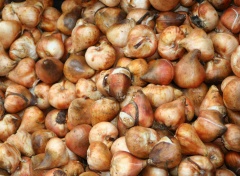Flower Bulbs
| Infobox on Flower Bulbs | |
|---|---|
| Example of Flower Bulbs |  |
| Facts | |
| Origin | Mostly the Netherlands |
| Stowage factor (in m3/t) | - |
| Humidity / moisture | See text |
| Ventilation | See text |
| Risk factors | See text |
Flower Bulbs
Description / Application / Shipment / Storage
Bulb production
In bulb cultivation, a distinction is made between spring-flowering and summer-flowering plants. Growers plant the small bulbs (the planting stock) from this first group that includes tulips, narcissi, hyacinths and crocus in the autumn. The flower bulb grower mulches the rows or beds of bulbs with straw to protect the bulbs during the freezing winter temperatures and/or to prevent the wind erosion of sandy soil. A hyacinth, for example, would freeze during a lengthy period of severe frost.
When the plants bloom in the spring, the grower will usually remove the flowers from the plants. The most important reasons for doing so are to prevent diseases and to encourage growth. Other aspects of cultivation include fertilising, irrigating, removing diseased plants and trueness to variety, and preventing disease. The summer months are the lifting period for spring-flowering bulbs in the period from half June until half July. The small flower bulbs are then separated from the larger saleable bulbs.
Summer-flowering plants such as dahlias, gladioli and lilies, are planted in the spring. The flower bulb grower lifts these bulbous plants before winter sets in, in the period from half September until half November. The cultivation methods are generally the same as for the spring-flowering types.
Flower bulbs are stored at a wide range of temperatures. Storage rooms are kept at temperatures from -2°C to +44°C. With all these different temperature treatments, Mother Nature can really be fooled. It is possible to encourage bulb production during the next growing season, to advance flowering or to retard it, to increase flower production, and even to control diseases. These kinds of treatments are used for flower bulbs throughout the bulb sector: among flower bulb growers, flower bulb dealers, special temperature treatment companies, bulb flower producers, etc.
In comparison with earlier days, the prices for flower bulbs have not risen. This is due to the advanced state of mechanisation combined with the development of large-scaled operations. Planting, applying and removing the winter mulch, deheading of the flowers, lifting, grading and even the traditional bulb peeling are mostly done by machine. This does not mean that labour problems don’t exist, however. In fact, next to the need to improve the environmental friendliness of the growing methods, this is one of the most important concerns for the bulb grower. Every year, it becomes more difficult to find temporary workers for the seasonal harvest peaks.











